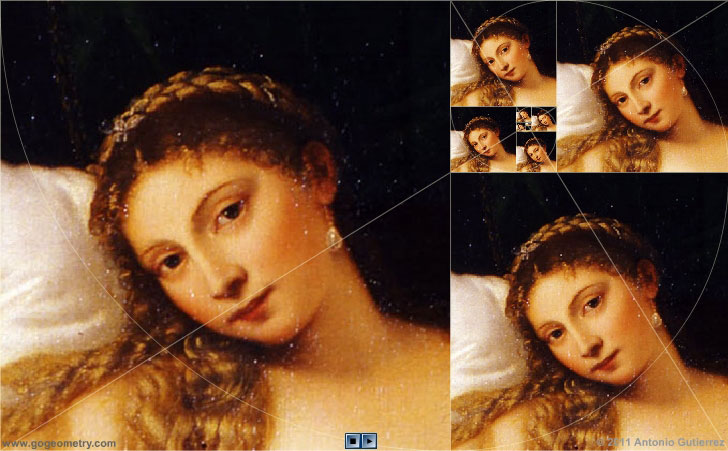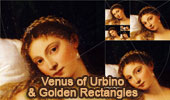Golden Harmony: Creating Golden Rectangles from the Face of Venus of Urbino

Successive Rectangles Dividing a Golden Rectangle into Squares - Inspired by Titian's Venus of Urbino.
Titian's "Venus of Urbino": A Geometrical Analysis of Composition, Proportions, and Perspective
We can analyze the painting from a geometrical
perspective in terms of composition, proportions, and
perspective:
Composition: The painting follows the
principles of composition, which involve arranging elements
within the painting to create a harmonious and balanced
visual effect. The positioning of Venus, the reclining nude
figure, and the surrounding objects such as the bed,
drapery, and flowers, all contribute to the overall
composition of the painting.
Proportions: Titian would
have used his knowledge of human anatomy and proportions to
depict the figure of Venus in a realistic and aesthetically
pleasing manner. Geometry, particularly the golden ratio,
may have been employed in determining the proportions of
Venus's body, the placement of her limbs, and the overall
balance of the composition.
Perspective: Titian also used
perspective techniques to create a sense of depth and
three-dimensionality in the painting. He would have employed
principles of linear perspective, such as vanishing points
and converging lines, to create a realistic sense of space
and depth within the painting.
Venus of Urbino by Titian
The Venus of Urbino is a 1538 oil painting by the Italian master Titian. It depicts a nude young woman, identified with the goddess Venus, reclining on a couch or bed in the sumptuous surroundings of a Renaissance palace. It hangs in the Galleria degli Uffizi in Florence.
Titian
Tiziano Vecelli or Tiziano Vecellio (c. 1488/1490 – 1576 better known as Titian) was an Italian painter, the most important member of the 16th-century Venetian school.
Uffizi Gallery
The Uffizi Gallery is a museum in Florence, Italy. It is one of the oldest and most famous art museums of the Western world. Building of the palace was begun by Giorgio Vasari in 1560 for Cosimo I de' Medici as the offices for the Florentine magistrates. Source: Wikipedia, Uffizi.
Golden rectangle
A golden rectangle
is a rectangle whose side lengths are in the golden ratio,
one-to-phi, that is, approximately 1:1.618. A distinctive
feature of this shape is that when a square section is
removed, the remainder is another golden rectangle, that is,
with the same proportions as the first. Square removal can
be repeated infinitely, which leads to an approximation of
the golden or Fibonacci spiral.
Droste Effect
The Droste effect is a specific kind of recursive picture, one that in heraldry is termed mise en abyme. An image exhibiting the Droste effect depicts a smaller version of itself in a place where a similar picture would realistically be expected to appear. This smaller version then depicts an even smaller version of itself in the same place, and so on. Only in theory could this go on forever; practically, it continues only as long as the resolution of the picture allows, which is relatively short, since each iteration geometrically reduces the picture's size. It is a visual example of a strange loop, a self-referential system of instancing which is the cornerstone of fractal geometry.
Source:
Wikipedia,
Droste Effect.

|